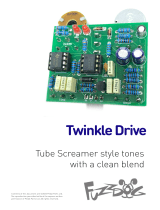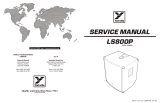Page is loading ...

Emperor Dual OD
Blues Breaker-based
boutique drive action
Contents of this document are ©2017 Pedal Parts Ltd.
No reproduction permitted without the express written
permission of Pedal Parts Ltd. All rights reserved.

Important notes
If you’re using any of our footswitch daughterboards,
DOWNLOAD THE DAUGHTERBOARD DOCUMENT
•Download and read the appropriate build document for the daughterboard
as well as this one BEFORE you start.
•DONOT solder the supplied Current Limiting Resistor (CLR) to the main
circuit board even if there is a place for it. This should be soldered to the
footswitch daughterboard.
POWER SUPPLY
Unless otherwise stated in this document this circuit is designed to be
powered with 9V DC.
COMPONENT SPECS
Unless otherwise stated in this document:
•Resistors should be 0.25W. You can use those with higher ratings but
check the physical size of them.
•Electrolytics caps should be at least 25V for 9V circuits, 35V for 18V
circuits. Again, check physical size if using higher ratings.
LAYOUT CONVENTIONS
Unless otherwise stated in this document, the following are used:
•Electrolytic capacitors:
Long leg (anode) to square pad.
•Diodes:
Striped leg (cathode) to square pad.
•ICs:
Square pad indicates pin 1.

Yet more important notes
specific to this circuit
CHANNEL ORDER
Our version of this circuit runs left channel (A) into right channel (B).
Why? Because that’s how it should be. If you don’t like it you’re welcome to
wire up the daughterboard differently, wiring IA and OA to IB and OB, and vice
versa. You should also flip the daughterboard and put the switches on the
other side. You’ll have to use long wires for the jack connections, but that’s
the price of putting it together differently to how it was designed.
HIGH GAIN VERSION
We can only go off the info that is out there in space. As far as we know, no-
one has identified the IC used in the new high-gain channel. Other
components have been identified and are (using Channel A BOM as ref):
R5 100K
C1 22n*
D5-6 1N1418 or 1N914
We cannot confirm these changes, so it’s up to you whether you want to
implement them. Without the specific IC used it’s unlikely to sound the
same as the original.
*The input cap is supposedly 22n on the input of both channels in the
high-gain version.

Schematic - Main PCB
The two channels are identical. The small circuit shown around IC1 is the charge pump.
The connections for the 4-way DIL clipping selector switch are shown above (S1.1 - S1.4).
Switches 1 and 2 will connect the two sets of diodes for circuit A, 3 and 4 for circuit B. You
can engage one, both or neither set of diodes for each circuit. You’ll notice big changes in
volume with the switches in different positions.

BOM - Main PCB
R1 1M
R2 1M
R3 27K
R4 33K
R5 10K
R6 10K
R7 220K
R8 6K8
R9 1K
R10 6K8
R11 1M
R12 1M
R13 1M
R14 27K
R15 33K
R16 10K
R17 10K
R18 220K
R19 6K8
R20 1K
R21 6K8
R22 1M
R23 47K
R24 47K
R25 47K
R26 47K
C1 10n
C2 100p
C3 10n
C4 10n
C5 100n
C6 10n
C7 10n
C8 1u
C9 1u
C10 10n
C11 100p
C12 10n
C13 10n
C14 100n
C15 10n
C16 10n
C17 1u
C18 1u
C19 10u elec*
C20 10u elec*
C21 10u elec*
C22 100u elec
C23 100u elec
C24 100u elec
D1-4 MA856
D56 1S1588
D7-10 MA856
D1112 1S1588
D13 1N4001
D1415 1N4148*
IC1 7660S*
ICA-B 4580
VOL 100KA
GAIN 100KB
TONE 25KB
PRES 50KB
OR 47/50K
TRIMMER
S1 4WAY DIL
SWITCH
*Only required if you’re
including the charge
pump.
The pads for SUPPLY-A and SUPPLY-B are 2.5mm apart, and will take standard
header pins or SPDT slide switches with that pitch. Use these to select 9 or 18V
supply for each circuit. You can hardwire either selection with jumper wires.
Diodes D1-D12 are the ‘magic ingredients’ in the original circuit, but they can be
replaced with others to suit your taste. Experiment.

Snap the small metal tag off the pots so
they can be mounted flush in the box. See
later in the document for tips on mounting.
Positive (anode) legs of the electrolytic
caps go to the square pads.
Negative (cathode) legs of the diodes go to
the square pads.
Be very careful when soldering the diodes
and LEDs. They’re very sensitive to heat.
You should use some kind of heat sink
(crocodile clip or reverse action tweezers)
on each leg as you solder them. Keep
exposure to heat to a minimum (under 2
seconds). Same goes for the ICs if you
aren’t using sockets.
You should solder all other board-
mounted components before you solder
the pots. Once they’re in place you’ll have
no access to much of the board.
Though we supply header pins with the
kit, there’s no reason you can’t attach the
two PCBs using ribbon cable or simply
wire. Totally up to you.
If you aren’t adding the charge pump
leave out C19-21, D14-15, IC1,
and place jumpers as shown below:
PCB layout ©2017 Pedal Parts Ltd.

BOM - Daughterboards
TRUE BYPASS
R1-2 CLR we use 2k2
SW1-2 3PDT ONON
Ensure switch lugs are horizontal
as shown in red above.
OPTICAL BYPASS
R1-2 2K2
C1-2 220n (these go on the underside of the PCB with the switches)
OK1-2 TLP222G
SW1-2 DPDT ONON
Ignore the two small pads marked in red above.
They’re simply vias used in routing the signals.

MAIN PCB ASSEMBLY
Nothing too unusual about it. We recommend placing some components on the pot side of
the PCB (as shown below) to give better clearance when joining the two PCBs together.
It’s best to lay C5, C18, C23 and C24 flat against the board.
Use EITHER a pot or trimmer for each PRESENCE control. You can’t use both. If using
trimmers make sure you put them on the opposite side of the PCB to the pots.
Place pots after all the other PCB-mounted parts. See next page for tips on getting them
mounted correctly.

We have a lot of pots on there and they all need to line up nicely, both with the PCB and each
other. The best way to do this is a combination of eye and using the enclosure for alignment.
Snap the small locator tags off each pot so they can sit right against the enclosure. Now put
each pot in place on the PCB. Now place the enclosure over the top of them as shown below,
so the pots sit in the holes. Do a quick visual check above and below the PCB to see if they’re
all straight.
Now solder in a single pin of each pot. Choose the one that’s most accessible. Once they’re
all tagged in, take the board away from the enclosure and do a visual check of the alignment.
If any are sitting at a different height to the others, melt the joint and adjust. Once you’re
happy everything is as it should be you can solder in the rest of the pins.
If you’re using long header pins to join the main PCB to the daughterboard, now is the time
to solder that in too. Put the short end of the headers into the main PCB, get it sitting at 90°
to the board and solder one pin. Check it is perfectly straight and solder the rest.
MOUNTING THE POTS
If you’re leaving out the Presence pots and want to have the Tone pots centered below the Vol
and Gain, you’re going to have to wire them. Simply bend the legs back on themselves so
they are well clear of the PCB and wire them up to the appropriate pads.

ASSEMBLE DAUGHTERBOARD
AND JOIN THE PCBS
This procedure is the same for both versions of the daughterboard.
Solder in your daughterboard resistors, caps and ICs as appropriate. Push your LEDs through
their pads (long leg to round pad), and bend the legs slightly so they can’t slide back out.
Set the height of your footswitches as desired using the lower nut in each case. It’s best to
have it at least one turn away from the main switch body so you aren’t putting any pressure
on that when attaching them to the enclosure. Now drop them into place on top of the
enclosure, including any internal hardware such as anti-vibration washer or locknut. Loosely
fasten them in from the other side using the other nut. Ensure they can still be moved.
Do the same with your main PCB - drop the pots through the holes in the enclosure and
fasten two or three of them from the other side.
Now drop your daughterboard over the header pins on the main PCB. They should line up
very well. Once located, drop the daughterboard further down and onto your switch pins.
The enclosure should have plenty of wiggle room where the pots and footswitches mount, so
getting a good fit should be no problem. Once you’re happy with placement, solder in your
footswitches and the headers.
Once you’ve done your final assembly and have the circuits in place actually INSIDE the box,
push your LEDs down into place and solder.

WIRE IT ALL UP
You should now have a fully assembled unit, ready for the offboard wiring. Of course, yours
will have ICs placed in the sockets now! So let’s get it wired up as shown below. If you don’t
want to use a battery just leave those connections out.
Obviously not to scale. You can use any type of jack sockets you like if you can fit them into
your enclosure. We’ve opted for Lumberg KLBs as they’re nice and dinky.
The battery will fit nicely in the recess between the footswitches, and will be disconnected
when you remove the input jack.

This template is a rough guide only. You should ensure correct marking of your
enclosure before drilling. You use this template at your own risk.
Pedal Parts Ltd can accept no responsibility for incorrect drilling of enclosures.
If you print this out, please measure the distances to ensure your printer hasn’t
increased or decreased the size.
FuzzDog.co.uk
Drilling template
Hammond 1590BB
It’s a good idea to drill the pots and
footswitch holes 1mm bigger if
you’re board-mounting them.
Wiggle room = good!
Recommended drill sizes:
Pots 7mm
Jacks 10mm
Footswitches 12mm
DC Socket 12mm
27mm
81mm
27mm 27mm
27mm
38mm
/














